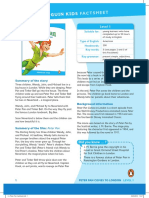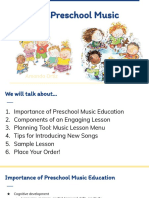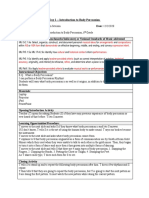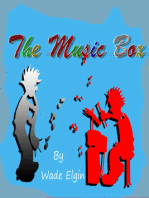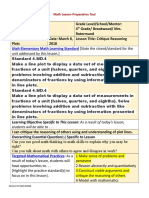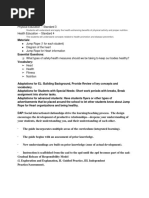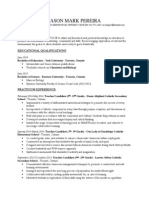0 ratings0% found this document useful (0 votes)
289 viewsGiraffes Cant Dance Text
Giraffes Cant Dance Text
Uploaded by
api-370939741The document provides details about a kindergarten lesson plan titled "Giraffes Can't Dance" based on the book of the same name. The lesson has three phases: in phase one, students watch a video of the book and discuss it; in phase two, students work in small groups to create dances representing passages from the book; in phase three, groups perform their dances for the class and all students dance together to the story and video. The lesson aims to use creative arts like dance to help students comprehend literature and see how dance can tell a story.
Copyright:
© All Rights Reserved
Available Formats
Download as PDF, TXT or read online from Scribd
Giraffes Cant Dance Text
Giraffes Cant Dance Text
Uploaded by
api-3709397410 ratings0% found this document useful (0 votes)
289 views5 pagesThe document provides details about a kindergarten lesson plan titled "Giraffes Can't Dance" based on the book of the same name. The lesson has three phases: in phase one, students watch a video of the book and discuss it; in phase two, students work in small groups to create dances representing passages from the book; in phase three, groups perform their dances for the class and all students dance together to the story and video. The lesson aims to use creative arts like dance to help students comprehend literature and see how dance can tell a story.
Original Title
giraffes cant dance text
Copyright
© © All Rights Reserved
Available Formats
PDF, TXT or read online from Scribd
Share this document
Did you find this document useful?
Is this content inappropriate?
The document provides details about a kindergarten lesson plan titled "Giraffes Can't Dance" based on the book of the same name. The lesson has three phases: in phase one, students watch a video of the book and discuss it; in phase two, students work in small groups to create dances representing passages from the book; in phase three, groups perform their dances for the class and all students dance together to the story and video. The lesson aims to use creative arts like dance to help students comprehend literature and see how dance can tell a story.
Copyright:
© All Rights Reserved
Available Formats
Download as PDF, TXT or read online from Scribd
Download as pdf or txt
0 ratings0% found this document useful (0 votes)
289 views5 pagesGiraffes Cant Dance Text
Giraffes Cant Dance Text
Uploaded by
api-370939741The document provides details about a kindergarten lesson plan titled "Giraffes Can't Dance" based on the book of the same name. The lesson has three phases: in phase one, students watch a video of the book and discuss it; in phase two, students work in small groups to create dances representing passages from the book; in phase three, groups perform their dances for the class and all students dance together to the story and video. The lesson aims to use creative arts like dance to help students comprehend literature and see how dance can tell a story.
Copyright:
© All Rights Reserved
Available Formats
Download as PDF, TXT or read online from Scribd
Download as pdf or txt
You are on page 1of 5
Abby Ryan
Bretten Allen
Kelsey Gile
Lesson Title: Giraffes Can’t Dance
Grade Level: Kindergarten
State Standards:
English Language Arts - Speaking and Listening Standard 1 - Participate in
collaborative conversations with diverse partners about kindergarten topics and texts
with peers and adults in small and larger groups.
English Language Arts - Reading: Literature Standard 3 - With prompting and
support, identify characters, settings, and major events in a story.
K.D.CR - Students will conceptualize, generate, develop, and organize artistic
ideas and work. They will complete and refine dance works.
Specific Lesson Objective:
Students will create a dance from a portion of text from a book.
Students will work in small groups to collaborate on a dance that makes sense
with the specific passage.
Lesson Purpose:
Guide students to use a more creative pathway to think about the literature that
they are reading/experiencing.
Students will be able to work in small and large groups in creative ways.
Essential Questions:
How can creative arts help with literary comprehension?
In what ways does dance help in telling a story?
Vocabulary Focus: dance, movement, creativity
Materials: Giraffes Can’t Dance text, document camera, computer access, YouTube
access https://www.youtube.com/watch?v=zvuNjPLP9J0&t=103s , large room
Anticipated Time Frame: 30 minutes
Adaptations for SPED and ELL:
Enlarge text, put pictures on smartboard, group students who need more
assistance with peers who grasp the assignment, give more time, model each step…
DAP:
Developmentally appropriate, going along with the grade standards, every
student can participate, hands on and minds on…
Phase I: Exploration and Explanation (10 minutes)
Ask students if they think animals can dance, small discussion
Play YouTube video of “Giraffes Can’t Dance”
https://www.youtube.com/watch?v=zvuNjPLP9J0&t=103s
Ask students what they liked about the book and what they learned
Give instructions for the lesson
Have students gather in a large open space
Work together as a class to determine dance moves for the green highlighted section
(the very end of the book text.)
Phase II: Guided Practice/Differentiation (10 minutes)
Split into three groups (using counting off method)
Each group will have one teacher to facilitate the creative process
Work together in each group to determine dance moves for one section
Practice the section as a whole
Phase III: Independent Practice/Assessment (10 minutes)
Come back together as a full class
Instruct students that they will go around the class in their groups and each group with
show their dance and then everybody will dance together at the end with the moves
learned in Phase I
Play the YouTube video and have students dance along as the story is being read out
loud
Gerald was a tall giraffe
Whose neck was long and slim
But his knees were awfully crooked
And his legs were rather thin
He was very good at standing still
And munching shoots off trees
But when he tried to run around
He buckled at the knees
Now every year in Africa
They hold the Jungle Dance,
Where every single animal
Turns up to skip and prance
And this year when the day arrived
Poor Gerald felt so sad,
Because when it came to dancing
He was really very bad
The warthogs started waltzing
And the rhinos rock’ n’ rolled.
The lions danced a tango
That was elegant and bold
The chimps all did a cha-cha
With a very Latin feel,
And eight baboons then teamed up
For a splendid Scottish reel
Gerald swallowed bravely
As he walked toward the floor
But the lions saw him coming,
And they soon began to roar.
“Hey, look at clumsy Gerald,”
the animals all sneered.
“Giraffes can’t dance, you silly fool!
Oh, Gerald, you’re so weird.”
Gerald simply froze up.
He was rooted to the spot.
They’re right, he thought.
I’m useless. Oh, I feel like such a clot.
So he crept off from the dance floor,
And he started walking home.
He’d never felt so sad before
So sad and so alone.
Then he found a little clearing,
And he looked up at the sky.
“The moon can be so beautiful,”
he whispered with a sigh
“Excuse me!” coughed a cricket
who’d seen Gerald earlier on.
“But sometimes when you’re different
you just need a different song.”
“Listen to the swaying grass
and listen to the trees.
To me the sweetest music
Is those branches in the breeze.
So imagine that the lovely moon
Is playing just for you –
Everything makes music
If you really want it to.”
With that, the cricket smiled
And picked up his violin.
Then Gerald felt his body
Do the most amazing thing.
His hooves had started shuffling,
Making circles on the ground.
His neck was gently swaying,
And his tail was swishing around
He threw his legs out sideways,
And he swung them everywhere.
Then he did a backward somersault
and leapt up in the air.
Gerald felt so wonderful
His mouth was open wide.
“I am dancing! Yes, I’m dancing!
I AM DANCING!” Gerald cried.
Then, one by one, each animal
who‘d been there at the dance arrived
while Gerald boogied on
and watched him, quite entranced
They shouted, “It’s a miracle!
We must be in a dream.
Gerald’s the best dancer
That we’ve ever, ever seen!”
“How did you learn to dance like that?
Please, Gerald, tell us how.”
But Gerald simply twirled around
And finished with a bow.
Then he raised his head and looked up
At the moon and stars above.
“We all can dance,” he said,
“when we find music that we love.”
https://www.youtube.com/watch?v=zvuNjPLP9J0&t=103s
You might also like
- Product Research - MavenportDocument1 pageProduct Research - MavenportyiyangNo ratings yet
- Christmas TV Show ScriptDocument10 pagesChristmas TV Show Scriptapi-690596217No ratings yet
- 12 Angry PigsDocument9 pages12 Angry Pigsleela kumaresanNo ratings yet
- Story Script (Chicka Chicka Boom Boom)Document4 pagesStory Script (Chicka Chicka Boom Boom)Wai HninNo ratings yet
- Gymboree SongDocument1 pageGymboree SongAliya JamesNo ratings yet
- John, Paul, George & Ben - Lane SmithDocument14 pagesJohn, Paul, George & Ben - Lane SmithSuzann Hughes0% (1)
- Marik ServitorsDocument20 pagesMarik ServitorsDWNloader100% (2)
- Story: The Elephant and The Bad Baby'Document7 pagesStory: The Elephant and The Bad Baby'Araceli AmorosNo ratings yet
- The Hague Summit in 1969 To Revive Integration MomemtumDocument7 pagesThe Hague Summit in 1969 To Revive Integration MomemtumNergis ÖkılıçNo ratings yet
- Chicka Chicka Boom BoomDocument2 pagesChicka Chicka Boom Boomvcmaduzia50% (2)
- Thanksgiving Song BookDocument12 pagesThanksgiving Song BookJennNo ratings yet
- Bear HuntDocument19 pagesBear HuntMas Kudin100% (1)
- Music Express Age 5-6 GLOSSARYDocument1 pageMusic Express Age 5-6 GLOSSARYLouieIsmaelNo ratings yet
- Stand and DeliverDocument11 pagesStand and DeliverSHREYA DASNo ratings yet
- Medland Rother Toyota Kata PDFDocument64 pagesMedland Rother Toyota Kata PDFcheri kokNo ratings yet
- Classroom Management PlanDocument11 pagesClassroom Management Planapi-340295431No ratings yet
- Preschool Lesson Plan 2Document6 pagesPreschool Lesson Plan 2api-340401996No ratings yet
- Irish Dance Lesson PlanDocument5 pagesIrish Dance Lesson Planapi-235247900No ratings yet
- Charlie Over The Ocean Singing Game PDFDocument3 pagesCharlie Over The Ocean Singing Game PDFapi-511177039No ratings yet
- Click Clack Moo Lesson PlanDocument5 pagesClick Clack Moo Lesson Planapi-544613150No ratings yet
- Tiny Tots: Creative Movement IDocument3 pagesTiny Tots: Creative Movement IJacquelineD'AmicoNo ratings yet
- Super Simple Songs Two Lyrics and ActionsDocument12 pagesSuper Simple Songs Two Lyrics and ActionsHiếu Nguyễn TấtNo ratings yet
- Vdocuments - MX Little Chickies Los Pollitos CanticosDocument5 pagesVdocuments - MX Little Chickies Los Pollitos Canticosnezuko tagiroNo ratings yet
- Approaching Choreography For Musical TheatreDocument4 pagesApproaching Choreography For Musical TheatreLubna MariumNo ratings yet
- The Benefits of Action SongsDocument6 pagesThe Benefits of Action Songsnaveenmanuel8879No ratings yet
- The Wheels On The Bus Learn ItDocument5 pagesThe Wheels On The Bus Learn ItLorena ArroyoNo ratings yet
- Square Dance Curriculum Project FinalDocument26 pagesSquare Dance Curriculum Project Finalapi-249892098No ratings yet
- The Tale of Peter Rabbit: Role-PlayDocument2 pagesThe Tale of Peter Rabbit: Role-PlaySarah KhanNo ratings yet
- Polar ExpressDocument20 pagesPolar Expressninicoff_7100% (2)
- Kickstart Lesson Giraffes Cant DanceDocument2 pagesKickstart Lesson Giraffes Cant Danceapi-351188250No ratings yet
- Songbook PDFDocument23 pagesSongbook PDFpilikyNo ratings yet
- Formation Dance StylesDocument2 pagesFormation Dance Stylesapi-241345937No ratings yet
- Sing Out Loud Children's Songs LyricsDocument12 pagesSing Out Loud Children's Songs Lyricsrocio_19No ratings yet
- L1 Peter Pan Teacher Notes American EnglishDocument10 pagesL1 Peter Pan Teacher Notes American Englishjoam28100% (1)
- Toddler StorytimeDocument6 pagesToddler Storytimeapi-320364228100% (1)
- Childrens SongsDocument18 pagesChildrens SongsdramankapoorNo ratings yet
- Cosi Study NotesDocument12 pagesCosi Study Notesapi-250740140No ratings yet
- Theater GamesDocument23 pagesTheater GamesPaola Quezada Yañez100% (1)
- Olsen Giraffe Ebook PDFDocument33 pagesOlsen Giraffe Ebook PDFMorgan EdwardsNo ratings yet
- Dr. Seuss Study GuideDocument25 pagesDr. Seuss Study GuideChildren's Theatre Company100% (1)
- Little Red Riding Hood Script PlayDocument4 pagesLittle Red Riding Hood Script Playzizi ibraNo ratings yet
- SFMT Performance Grades Qual Spec G1-8 Jan2024.pdf - 0Document137 pagesSFMT Performance Grades Qual Spec G1-8 Jan2024.pdf - 0MadushanNo ratings yet
- Workshop Facilitator/Theatre-In-Education CVDocument2 pagesWorkshop Facilitator/Theatre-In-Education CVdanakohavasegalNo ratings yet
- Finger Plays CollectionDocument11 pagesFinger Plays CollectionShyamakrishna KrishnaNo ratings yet
- Bears Everywhere - Songs Poems and Fingerplays PDFDocument30 pagesBears Everywhere - Songs Poems and Fingerplays PDFLourdes Gimenez NaveaNo ratings yet
- Planning Preschool Music LessonsDocument20 pagesPlanning Preschool Music Lessonsapi-573191175100% (1)
- Mothers' Day Song BookDocument5 pagesMothers' Day Song BookJennNo ratings yet
- The Beauty and The BeastDocument5 pagesThe Beauty and The BeastEder Orga Ricse0% (1)
- Resource Pack Eyfs Music LTPDocument38 pagesResource Pack Eyfs Music LTPLinzi LedgerwoodNo ratings yet
- Charlotte's Web MonologuesDocument2 pagesCharlotte's Web MonologuesLeah PorrataNo ratings yet
- Pete The Cat Buttons LessonDocument6 pagesPete The Cat Buttons Lessonapi-285851205No ratings yet
- Body PercussionDocument7 pagesBody PercussionMarcelo RojoNo ratings yet
- Color SongsDocument13 pagesColor SongsapplechickyNo ratings yet
- Day 1 - Body Percussion LessonDocument3 pagesDay 1 - Body Percussion Lessonapi-533508550No ratings yet
- Hymes Ongs: For Babies and ToddlersDocument20 pagesHymes Ongs: For Babies and ToddlersElumalai SrinivasanNo ratings yet
- Games in A Theatre ClassroomDocument17 pagesGames in A Theatre Classroomajayshandilya4309No ratings yet
- The Children's TheaterDocument6 pagesThe Children's TheaterScribdTranslationsNo ratings yet
- Learning Through Story and DramaDocument4 pagesLearning Through Story and DramaIrene BPNo ratings yet
- Au MFL 2548556 My Body Differentiated Worksheets Indonesian - Ver - 4Document4 pagesAu MFL 2548556 My Body Differentiated Worksheets Indonesian - Ver - 4Fery SitepuNo ratings yet
- James and The Giant Peach: Two Beans ProductionsDocument6 pagesJames and The Giant Peach: Two Beans ProductionsEva Beverly WongNo ratings yet
- Sped Final EvaluationDocument6 pagesSped Final Evaluationapi-370939741No ratings yet
- Roosevelt Kinder GroupDocument4 pagesRoosevelt Kinder Groupapi-370939741No ratings yet
- Utah Elementary Math Learning Standard: Unit Addressed by This Lesson.)Document8 pagesUtah Elementary Math Learning Standard: Unit Addressed by This Lesson.)api-370939741No ratings yet
- Utah Elementary Math Learning Standard: Math Lesson-Preparation ToolDocument9 pagesUtah Elementary Math Learning Standard: Math Lesson-Preparation Toolapi-370939741No ratings yet
- Sped Color PoemsDocument5 pagesSped Color Poemsapi-370939741No ratings yet
- Reading Street Lost City 1Document4 pagesReading Street Lost City 1api-370939741No ratings yet
- Money Math LPDocument2 pagesMoney Math LPapi-370939741No ratings yet
- Data CollectionDocument2 pagesData Collectionapi-370939741No ratings yet
- Parklane LP 1 1Document3 pagesParklane LP 1 1api-370939741No ratings yet
- Lesson PlanDocument4 pagesLesson Planapi-370939741No ratings yet
- Finger Biter: Legal InformationDocument12 pagesFinger Biter: Legal InformationJazon McfaddenNo ratings yet
- IPsec VPNDocument260 pagesIPsec VPNSholl1No ratings yet
- #21022626-Incident Report RedactedDocument5 pages#21022626-Incident Report RedactedDarin BiddleNo ratings yet
- Accession in Its Three Forms of Building, Natural, Such As Alluvion, AvulsionDocument4 pagesAccession in Its Three Forms of Building, Natural, Such As Alluvion, AvulsionCaitlin KintanarNo ratings yet
- Neville Goddard DreamsDocument8 pagesNeville Goddard DreamsNevillution100% (1)
- Economic Viability of Kite-Based Wind Energy Power PDFDocument12 pagesEconomic Viability of Kite-Based Wind Energy Power PDFreemNo ratings yet
- TCDSB Resume 2Document2 pagesTCDSB Resume 2api-250786275No ratings yet
- Animating or Ensouling A Statue OutlineDocument4 pagesAnimating or Ensouling A Statue Outlinebrentjacobs022No ratings yet
- Ib Business Management - Adaptive and Innovative Creativity PDFDocument2 pagesIb Business Management - Adaptive and Innovative Creativity PDFGiris GovindNo ratings yet
- 434 MFRDocument10 pages434 MFRHarsh JindalNo ratings yet
- Strategies How To Teach Listening For Young Learners: Indah Nurhidayati Nugroho Anggara PutraDocument11 pagesStrategies How To Teach Listening For Young Learners: Indah Nurhidayati Nugroho Anggara PutraSi Eneng VanZyNo ratings yet
- Printed Folded Dipole Array Antenna With Directional Radiation For 2.4 5 GHZ Wlan OperationDocument2 pagesPrinted Folded Dipole Array Antenna With Directional Radiation For 2.4 5 GHZ Wlan OperationJuampi MochenNo ratings yet
- Philamlife Vs Pineda (Masiglat)Document1 pagePhilamlife Vs Pineda (Masiglat)Francis MasiglatNo ratings yet
- MCA Syllabus PDFDocument87 pagesMCA Syllabus PDFSEENIVASNo ratings yet
- Applied Quiz 2Document1 pageApplied Quiz 2saintaloysiusgonzaga06No ratings yet
- Trustco Insurance T/a Legal Shield Namibia and Another V Deed Registries Regulation Board and Others (2011) NASC 10 SA 14/2010 (15 July 2011)Document22 pagesTrustco Insurance T/a Legal Shield Namibia and Another V Deed Registries Regulation Board and Others (2011) NASC 10 SA 14/2010 (15 July 2011)André Le RouxNo ratings yet
- Alamdari, Kazem. "IS DEMOCRACY A PREREQUISITE OF ECONOMIC GROWTH?" Michigan Sociological Review, No. 8, 1994, Pp. 19Document2 pagesAlamdari, Kazem. "IS DEMOCRACY A PREREQUISITE OF ECONOMIC GROWTH?" Michigan Sociological Review, No. 8, 1994, Pp. 19zainudinNo ratings yet
- RPT GuideDocument31 pagesRPT Guidesantiago_vNo ratings yet
- Mcqs On Pharmaceutical Organic Chemistry IIDocument14 pagesMcqs On Pharmaceutical Organic Chemistry IIAnil ParmarNo ratings yet
- NSMC CommandDocument380 pagesNSMC Commandanh00No ratings yet
- Final Communication Plan Team ReportDocument12 pagesFinal Communication Plan Team ReportMolly StolzNo ratings yet
- Are We There Yet?: by R. Carlton WynneDocument2 pagesAre We There Yet?: by R. Carlton WynneEduard Loberez ReyesNo ratings yet
- Young Stock Management Training Manual and GuidelineDocument58 pagesYoung Stock Management Training Manual and GuidelineAzizrahman Abubakar100% (2)
- Al Khawarizmi The Father of AlgebraDocument11 pagesAl Khawarizmi The Father of AlgebraBhavaniNo ratings yet

































